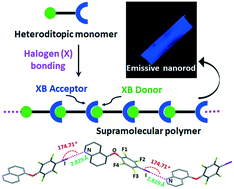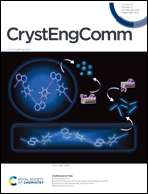Structural influence on stimuli-responsive halogen-bonded luminescent supramolecular polymers from heteroditopic isomers†
Abstract
Supramolecular polymers have emerged as attractive systems for the construction of responsive and adaptive smart materials. In this context, halogen (X)-bonding is relatively underexplored. The present work describes an X-bonded supramolecular polymer from a rationally designed AB-type heteroditopic self-complementary crystallizable building block of 5-(2,3,5,6-tetrafluoro-4-iodophenoxy)quinoline that produces discrete nanorods in methylcyclohexane (MCH) with blue emission. A structural isomer with variation in the position of the X-bond donor shows a stark contrast in the crystalline packing and solution-phase self-assembly, which was attributed to the difference in the strength and directionality of the X-bonding interaction. A structurally close control molecule, in which the X-bond donating iodine atom is replaced with fluorine, failed to produce any defined nanostructure in MCH, suggesting that the molecular assembly is predominantly driven by the X-bonding interaction.

- This article is part of the themed collections: Chemistry of polymers - Chemical Science symposium collection and Supramolecular & Polymorphism


 Please wait while we load your content...
Please wait while we load your content...